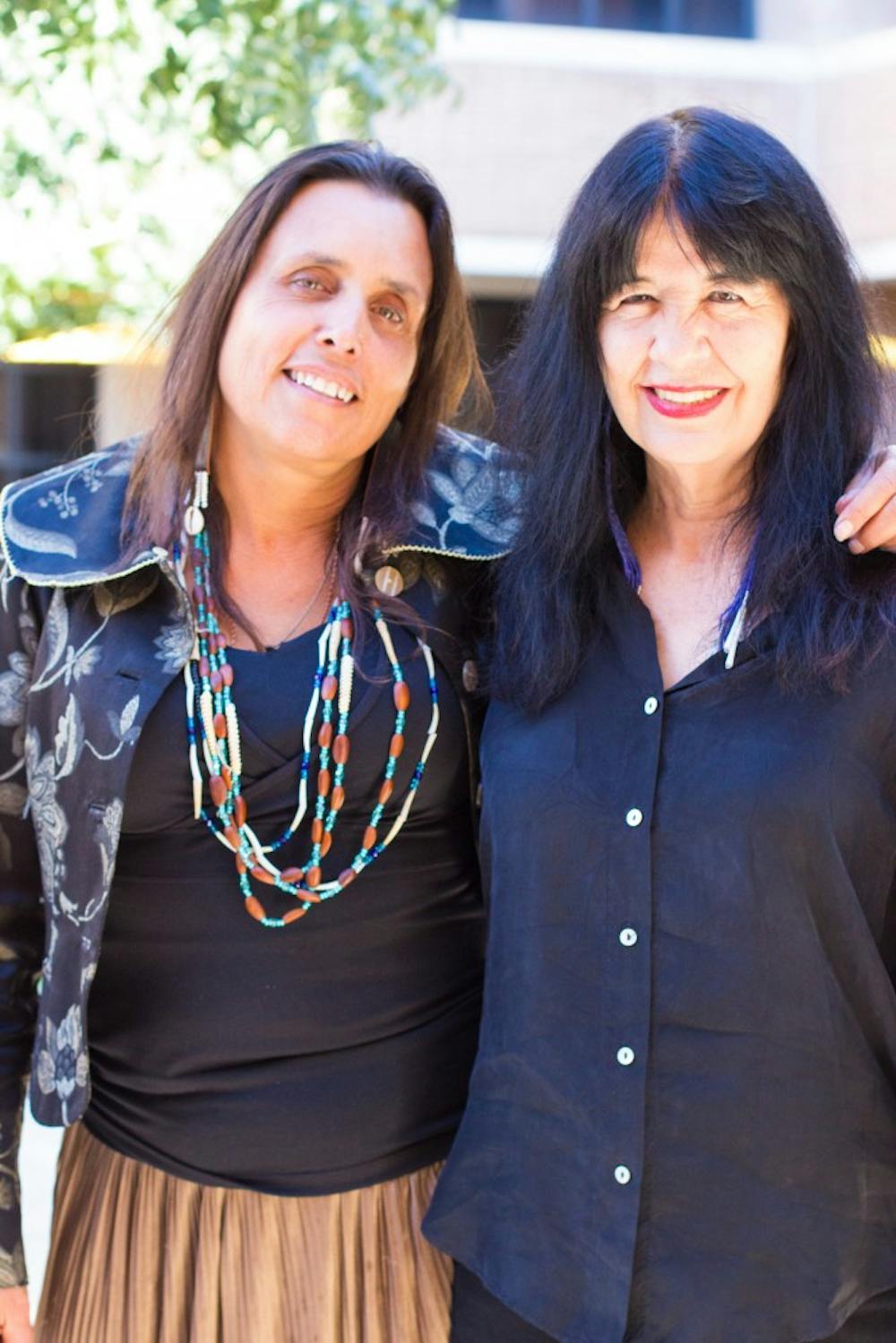 Joy Harjo (right) and Winona LaDuke presented at ASU's West campus on Oct. 2. (Courtesy of Ruth Dempsey)
Joy Harjo (right) and Winona LaDuke presented at ASU's West campus on Oct. 2. (Courtesy of Ruth Dempsey)American Indian activist and environmentalist Winona LeDuke closed up a week of environmental and cultural appreciation at the West campus in her keynote speech this evening, Thursday, October 2.
The events opened Tuesday with "Crazy Brave" author Joy Harjo discussing with Honors students at the West campus Barrett suite, then giving a presentation in the Kiva Lecture Hall.
Welcoming all the speakers were pieces of art made by New College freshmen who all read Harjo’s memoir "Crazy Brave" before arriving on campus, as well as LeDuke’s impressive TEDtalk on culture and the environment. This artwork was put on display since the beginning of the school year was appreciated by the guests. Harjo, a former professor, commented on her appreciation of the gesture in talking with the Barrett students.
“It was very thoughtful,” she said. “For all the students to take the time and thought into such beautiful pieces before school started was really wonderful.”
Communication freshman Diego Ley was particularly impressed with Harjo’s peaceful demeanor and storytelling in her presentations.
“(Harjo) told us about the time she was driving in the Northwest and she saw a bald eagle flying against the wind current,” he said. “It kept fighting until eventually it came to glide smoothly with the wind. I really liked that metaphor for life. You’re going to face struggles, but you still need to go for it.”
LeDuke conducted her lecture at the La Sala ballroom, reminding students of the environmental problems we face and how we can learn from indigenous, American Indian cultures on how to better consumers.
In her discussion of the lasting divide in cultural appreciation for American Indian students, she recounted her experiences studying at Harvard.
“At Harvard, if you wanted to study European art you would go to the Fine Arts Department," she said. "If you wanted to study Native American art, you would have to go to the Anthropology section. It might be time to restudy that paradigm.”
She linked her knowledge and appreciation of Native American culture to being able to help the environment.
“Where will we be 50 years from now?,” she asked. “The prophets of our people talked about many of our people disappearing. I think they were talking about smallpox them. Today, we have other environmental worries.”
The solution to these problems, she says, is in the appreciation and growth of crops and other forms of self-sufficiency. She tells the time of when her American Indian father came to visit her at college.
‘I tried to tell him about the philosophy I learned,” she said. “He said, ‘Winona, I don’t want to hear your philosophy if you can’t grow corn.’ And so I listened, and I’ve never had a failing crop.”
The need for this solution was shown in an impactful map of the correlation between natural hazards in the U.S. and mortality rates. She predicted that by the year 2020, over $1 billion will have to be used to help solve for natural disasters.
Forensics freshman Renee Romero found hope in her presentation despite the looming issues.
“It was so amazing to see how she is making a difference herself in her community,” she said. “It definitely made the problems seem to be more solvable.”
Romero is referring to efforts LeDuke made to help her community by assisting to build a wind turbine, stop unnatural oil processes from gaining ground and her efforts in building a solar panel by the lake where she lives.
“It is important that we all try to be 100 percent solar as soon as possible,” she said.
Alumni Julius Badoni and Robin Notah were delighted to see LeDuke speak.
“We studied her back when I was in college, about 10 years ago,” Notah said. “She is an asset to the American Indian community especially in the areas of environment and politics.”
Badoni, too, had reminiscent thoughts on the presentation.
“For me, it was about rereading the books I read in college with her… This event is helpful in showing and appreciating the Native American culture which is really important,” he said.
Jacob Moore, the assistant vice president of Tribal Relations at the close of the evening summarized its significance.
“This year we have 2,466 American Indians enrolled at ASU," he said. "This is the 2nd highest in the nation. Because of this, we are a premier institution for American Indian students, and this presentation was a prime example of us as a university, and institute of learning, fulfilling that duty."
Reach the reporter at rtashboo@asu.edu or follow her on Twitter at @Rachael_Ta
Like The State Press on Facebook and follow @statepress on Twitter.




